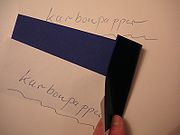
Carbon copy
Encyclopedia

Carbon paper
Carbon paper is paper coated on one side with a layer of a loosely bound dry ink or pigmented coating, usually bound with wax. It is used for making one or more copies simultaneous with the creation of an original document...
to produce one or more copies simultaneously during the creation of paper documents. With the advent of email
Email
Electronic mail, commonly known as email or e-mail, is a method of exchanging digital messages from an author to one or more recipients. Modern email operates across the Internet or other computer networks. Some early email systems required that the author and the recipient both be online at the...
, the term has also come to refer to simultaneously sending copies of an electronic message to secondary recipients.
Use
A sheet of carbon paper is placed between two sheets of paper and the pressure applied by the writing implement (pen, pencil, typewriter or impact printer) to the top sheet causes pigment from the carbon paper to make a similar mark on the copy. More than one copy can be made by stacking several sheets with carbon paper between each pair. Four or five copies is a practical limit. The top sheet is the original and each of the additional sheets is called a carbon copy.The use of carbon copies declined with the advent of photocopying and electronic document creation and distribution (word processing). Carbon copies are still used in special applications, for example, in manual receipt books which have a multiple-use sheet of carbon paper supplied, in order that the user can keep an exact copy of each receipt issued, although even here carbonless copy paper
Carbonless copy paper
Carbonless copy paper , non-carbon copy paper, or NCR paper is an alternative to carbon paper, used to make a copy of an original, handwritten document without the use of any electronics...
is often used to the same effect.
It is still common for a business letter
Business letter
A commercial business letter is a letter written in formal language, usually used when writing from one business organization to another, or for correspondence between such organizations and their customers, clients and other external parties. The overall style of letter will depend on the...
to include, at the end, a list of names preceded by the abbreviation "cc:", indicating that the named persons are to receive copies of the letter, even though carbon paper is no longer used to make the copies. (An alternative etymology is that "c:" was used for copy and "cc:" indicates the plural, just as "p." means page and "pp." means pages.)
The term "carbon copy" can be used in reference to anything that was a near duplicate of an original ("...and you want to turn him into a carbon copy of every fourth-rate conformist in this frightened land!", Heinlein, Stranger in a Strange Land
Stranger in a Strange Land
Stranger in a Strange Land is a 1961 science fiction novel by American author Robert A. Heinlein. It tells the story of Valentine Michael Smith, a human who comes to Earth in early adulthood after being born on the planet Mars and raised by Martians. The novel explores his interaction with—and...
).
E-mail
Electronic mail, commonly known as email or e-mail, is a method of exchanging digital messages from an author to one or more recipients. Modern email operates across the Internet or other computer networks. Some early email systems required that the author and the recipient both be online at the...
, the abbreviation CC indicates those who are to receive a copy of a message addressed primarily to another. The list of CCed recipients is visible to all other recipients of the message. An additional BCC (blind carbon copy
Blind Carbon Copy
In the context of correspondence, blind carbon copy refers to the practice of sending a message to multiple recipients in such a way that conceals the fact that there may be additional addressees from the complete list of recipients...
) field is available for hidden notification; recipients listed in the BCC field receive a copy of the message, but are not shown on any other recipient's copy (including other BCC recipients). It is considered good practice to indicate to the other recipients that a new participant has been added to the list of receivers (e.g. by writing "I have CCed Rudolf Grabner").
In common usage, the To field recipients are the primary audience of the message, CC field recipients are others whom the author wishes to publicly inform of the message, and BCC field recipients are those surreptitiously being informed of the communication. Additionally, an LCC field (for "List Courtesy Copy') is available for e-mail distribution lists that, like BCC, hides the full recipient list but, unlike BCC, alerts recipients that other unnamed members of the list have been included in the distribution.
Printers
Dot matrix and daisy wheelDaisy wheel printer
Daisy wheel printers use an impact printing technology invented in 1969 by David S. Lee at Diablo Data Systems. It uses interchangeable pre-formed type elements, each with typically 96 glyphs, to generate high-quality output comparable to premium typewriters such as the IBM Selectric, but two to...
printers are also able to use carbon paper to produce multiple copies of a document in one pass, and most models feature adjustable impact power and head spacing to accommodate up to three copies plus the original printout. Usually, this feature is used in conjunction with continuous, prearranged perforated paper and carbon supplies for use with a tractor feeder, rather than with single sheets of paper, for example, when printing out commercial invoices or receipts.

